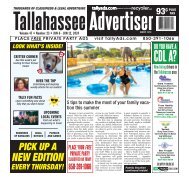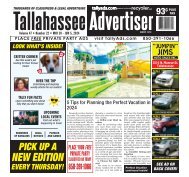Create successful ePaper yourself
Turn your PDF publications into a flip-book with our unique Google optimized e-Paper software.
THETRUCKER.COM OCTOBER 2023 • 11<br />
BUSINESS<br />
Going down?<br />
ANALYSTS DEBATE HOW LONG FREIGHT RATES WILL REMAIN LOW<br />
Those who were hoping that freight rates<br />
might begin to rebound in August were<br />
disappointed — and the disappointment is<br />
likely to continue for a few more months.<br />
Average dry van spot rates increased<br />
slightly in August, up just 0.7% from July<br />
numbers, according to DAT Trendlines.<br />
Compared with August of 2022, however, dry<br />
van rates fell a more dramatic 17.7%.<br />
The number of available trucks has<br />
continued to grow while the number of loads<br />
has not, resulting in a decline of 19.9% in DAT’s<br />
load-to-truck ratio. More trucks competing<br />
for fewer loads drives rates downward. The<br />
average spot rate for dry van was $2.08 per<br />
mile in August, according to DAT.<br />
On the temperature-controlled side, rates<br />
increased 2.6% from July but were down 13.9%<br />
from August 2022, as the load-to-truck ratio<br />
dropped by 37.8%. Spot rates averaged $2.50<br />
for refrigerated trailers in August.<br />
The flatbed load-to-truck ratio was even<br />
worse, declining by 57.2% compared with<br />
August 2022. Flatbed spot rates fell 1.1% from<br />
July rates and 17.6% from August 2022 rates.<br />
The average spot rate for flatbed freight in<br />
August was $2.50, according to DAT.<br />
Fuel costs rose by 12.6% during August but<br />
are still 12.8% lower than in August 2022.<br />
Loads posted on the Truckstop.com board<br />
in August followed a similar trajectory, as<br />
reported by FTR Transportation Intelligence.<br />
The board reported some rate increases due<br />
CLIFF ABBO<strong>TT</strong> | SPECIAL CORRESPONDENT<br />
to the Labor Day holiday but reported that<br />
average rates were still 21% lower than the<br />
five-year average for that holiday week.<br />
According to the Motive Monthly Economic<br />
Report, key metrics in retail visits improved<br />
in August. Motive’s data points differ from<br />
other analysts in that its data is compiled using<br />
GPS information collected from trucks<br />
that utilize their equipment, counting actual<br />
truck visits to retailers and other statistically<br />
valuable locations.<br />
Motive reported that retail visits were<br />
higher in August compared with August 2022,<br />
a good sign that the economy is beginning to<br />
show signs of growth.<br />
At the same time, the number of new<br />
carrier registrations with the Federal Motor<br />
Carrier Safety Administration grew in August,<br />
while carrier exits declined sharply. This<br />
means more trucks are engaging in the hunt<br />
for freight, helping keep rates low.<br />
The Motive report also indicates that<br />
rising diesel prices and increasing costs for<br />
credit will add difficulty for smaller trucking<br />
operations.<br />
The report states that Motive expects the<br />
overall contraction (the removal of trucks<br />
from the marketplace) to continue into<br />
early 2024, and truck owners are advised to<br />
prioritize operational efficiency. Conserving<br />
cash is the best defense a small business has<br />
against difficult business periods.<br />
“Destocking” is a work that has been<br />
iStock Photo<br />
Freight rates continued their downward trend in August, but most analysts predict improvement during the fourth<br />
quarter of the year.<br />
frequently used during the freight downturn.<br />
Simply put, it means retail establishments<br />
and manufacturers have been ordering less<br />
product to restock their shelves in response<br />
to slowed sales. By measuring the number<br />
of truck visits to distribution centers for the<br />
top 50 retailers, Motive can create its “Big Box<br />
Retail Index.”<br />
The index for August didn’t quite make it<br />
to July levels, primarily because of the July 4<br />
SEE TONNAGE ON PAGE 14<br />
Pilot program explores potential of mileage-based user fees<br />
iStock Photo<br />
The Eastern Transport Coalition has revealed the findings of an international<br />
mileage-based truck pilot that highlights the potential of a mileagebased<br />
user fee to reestablish the link between use and payment of the<br />
transportation system.<br />
THE TRUCKER NEWS STAFF<br />
COLLEGE PARK, Md. — The Eastern Transport Coalition<br />
recently revealed the findings of its international mileagebased<br />
truck pilot, the first of its kind, highlighting the potential<br />
of a mileage-based user fee (MBUF) to reestablish the link<br />
between use and payment of the transportation system.<br />
The real-world pilot was conducted from June to November<br />
2022 and included more than 250 diverse commercial vehicles,<br />
recording more than 8 million miles covering all 48 contiguous<br />
U.S. states and four Canadian provinces. This initiative built<br />
on the Coalition’s previous pilots by exploring how an MBUF<br />
could account for the complexities of the trucking industry.<br />
The work was conducted under the supervision of the U.S. Department<br />
of Transportation’s Surface Transportation Systems<br />
Funding Alternative (STSFA) program.<br />
As the transportation industry evolves with technology, the<br />
traditional fuel tax funding model is strained by the increased<br />
fuel efficiency and the steady growth of electric vehicles. The<br />
Coalition has explored MBUF since 2018 as an alternative to the<br />
fuel tax through nine passenger and three commercial vehicle<br />
pilots, public opinion surveys, focus groups and data analysis.<br />
With a neutral stance on MBUF as the ultimate solution, the<br />
Coalition’s emphasis lies in equipping decision makers with information<br />
about how all users could pay for transportation.<br />
From the beginning, the Coalition has encouraged the inclusion<br />
of the trucking industry’s voice in the national conversation<br />
surrounding MBUF. Acknowledging the trucking industry’s valuable<br />
role in sustaining both daily life and the nation’s economy,<br />
the Coalition has worked to bridge the gap between stakeholders,<br />
policymakers, and industry experts. The outcome is innovative<br />
strategies that not only address challenges faced by the trucking<br />
sector but also enrich the broader transportation network.<br />
“Central to the Coalition’s mission is its commitment to<br />
cultivating open dialogue and transparency throughout decision-making,”<br />
said Dr. Patricia Hendren, executive director of<br />
the Coalition. “By fostering collaboration among stakeholders,<br />
the Coalition envisions pioneering innovative solutions that<br />
drive progress reflective of the complex trucking industry and<br />
the evolving needs of our transportation system.”<br />
David Heller, senior vice president of safety and government<br />
affairs for the Truckload Carriers Association (TCA), also<br />
weighed in.<br />
“Looking for dollars to support our nation’s infrastructure<br />
is not an easy task, and no stone should be left unturned,” he<br />
said. “However, any mechanism, including an MBUF, needs to<br />
be fully vetted to determine whether it is a viable option to consider<br />
in the future.”<br />
“Results from this international pilot underscore the potential<br />
of MBUF as a catalyst for a transparent and scalable high-<br />
SEE PILOT ON PAGE 30

















